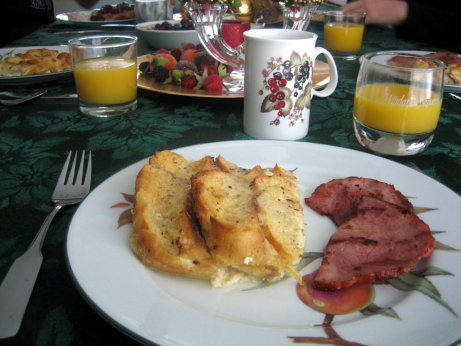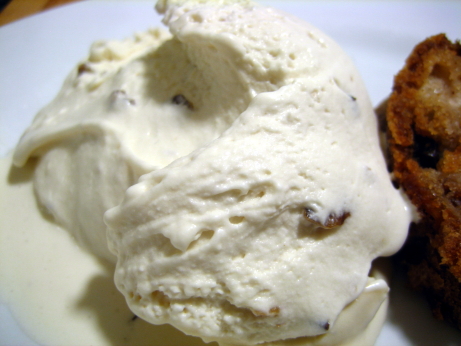The blurb for this recipe suggests that it’s an easy and fuss-free way to make French Toast. I couldn’t disagree more. This looks like a scaled down restaurant recipe to me, and what works for breakfast for hundreds doesn’t necessarily make much sense when serving six. The idea with the recipe is to make a basic French toast batter (eggs, milk, salt) and pour it over buttered slices of bread in a buttered baking dish. You then let the mixture soak into the bread in the fridge for at least an hour. The bread then needs to warm up to room temperature, whereupon it’s sprinkled with sugar and baked in a 450 oven for 20 to 25 minutes. I can make normal people French toast for six and have everything cleaned up in 25 minutes, so what’s the point of this recipe? The Book suggests that you should assemble the dish and let the bread soak overnight, so that it can be popped in the oven while you’re setting the table and squeezing the orange juice (I wonder how many oranges are juiced rhetorically for every real life glass of fresh squeezed orange juice). I guess one advantage of this approach is that all the dishes can be done the night before, and you do have a bit less to do in the morning. But you also have to wake up extra early to take the baking dish out of the fridge and preheat the oven. Making normal French toast requires washing a cutting board, a mixing bowl, and a frying pan. I’m willing to wait until after breakfast to get to those. If I was serving this dish to twenty people this approach would make a lot of sense, but as it is it’s more trouble than it’s worth.
The greatest crime of this recipe is that it didn’t taste particularly good. There was nothing bad or objectionable about it, but it was very very dull. I always add vanilla, cinnamon, and nutmeg to my French toast, and I prefer to use a more interesting bread (sourdough is good) than the “soft supermarket Italian” loaf the recipe calls for. I understand that French toast is mostly a vehicle for maple syrup delivery, but that doesn’t mean that it needs to be boring. I should give The Book due credit for calling for whole milk in the recipe, I was sure they’d find a way to integrate heavy cream.
If I had a giant group coming for breakfast I’d consider tripling this recipe, and adding some flavour to it. Beyond spices and different bread I’d increase the called for 1/4 teaspoon of salt to 1/2 teaspoon. As it was it was OK, we ate it, and once it was drowned in maple syrup we enjoyed it, but I’d say this recipe is a definite missed opportunity.

